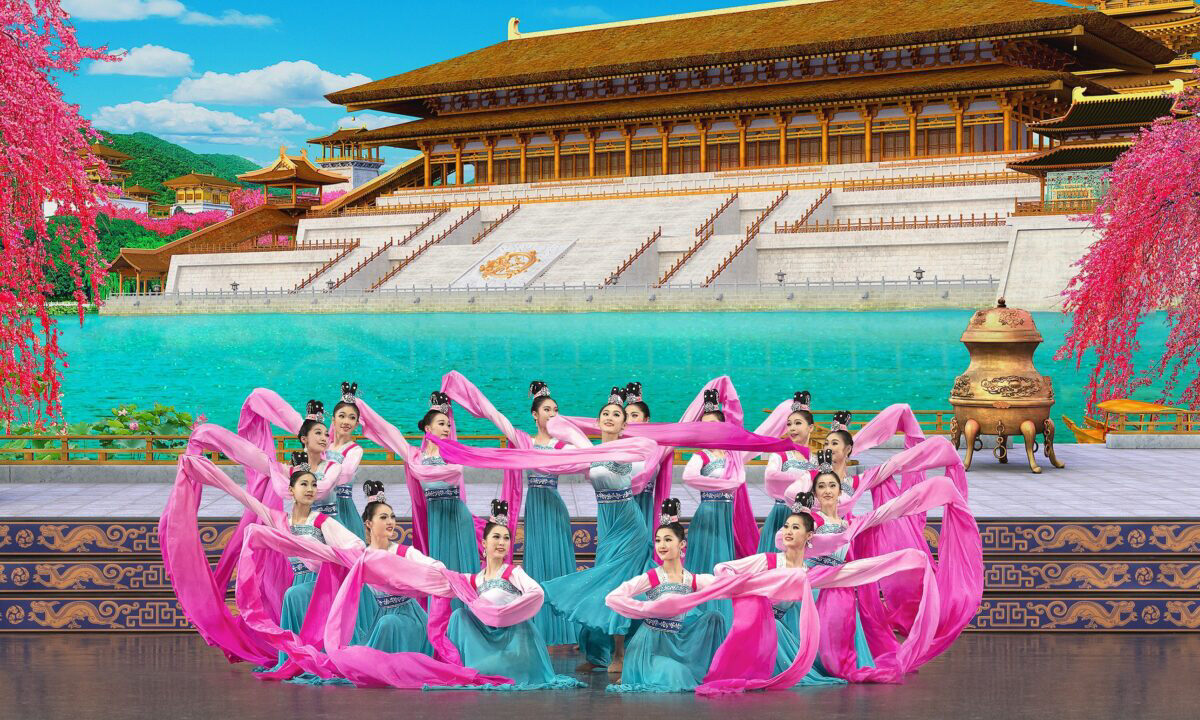
Water Sleeves, a classical Chinese dance from a Shen Yun performance. (Shen Yun Performing Arts)
By Catherine Yang
It’s no secret that many of Shen Yun Performing Arts’ earliest dancers were alumni of China’s Beijing Dance Academy. Yet a decade after New York-based Shen Yun’s inception, its performances started to look worlds apart from that of any Chinese dance company.
“Think about it, Beijing [Dance Academy] has its pick of the best dancers from not hundreds but thousands across the country. When we [Shen Yun] began, it certainly wasn’t like that,” said Gu Yun, one such alumnus who is a longtime dance teacher and choreographer with Shen Yun. When Shen Yun’s dance academy was newly formed, it received applicants who were more eager than trained.
In September, Gu gave an interview in New York state in between judging an international classical Chinese dance competition, to which dancers from around the world had applied. He said that those who weren’t from Shen Yun had applied hoping to learn more about Shen Yun’s dance method, which, since its introduction to the public, has become the high bar that classical Chinese dancers aspire to reach.
The Difference Is Plain to See
In a recent video profile on the website Shen Yun Creations, company principal dancer Steven Wang described what his dance experience in China was like compared to his experience with Shen Yun in New York.
“When I was 12 years old, I was accepted into a professional dance academy, and I’ve been dancing ever since. It’s been around 20 years,” he said.
“The style of dance I studied in China, when you do movements, you would put in a lot of your own little quirks. But if you are to do Shen Yun’s style of classical Chinese dance, you would need to do it with a grand bearing. For example, when the men dance, they have to be very masculine, valiant, and majestic.
“Every preparatory move, every pose, every expression, gives the dance a feeling of grandeur. And when you complete a technique, you finish off with a dignified pose.”
For example, “if you were doing the ‘Han Tang’ style of dance inside China,” dancers finish off their movements by contracting into a ball, “as if [they’re] crawling on the ground.”
“So just this alone draws a very stark contrast,” he said.
Shen Yun’s dancers often describe the aesthetic the company pursues as “grand.” The artists strive to present a dignified view of humanity in their dances, in line with the values of traditional Chinese culture, which has respect for the divine as one of its core beliefs. It also holds the view that man was created in the image of gods, by a supreme Creator.
It is not for a lack of trying that mainland Chinese dance schools and companies, all with ties to the Chinese communist regime, have failed to capture international audiences.
When Shen Yun, with its mission of reviving divinely inspired traditional Chinese culture through the arts, first gained world renown, the Chinese Communist Party’s reaction was to try to steal its thunder and take control of the narrative. It created some 60 Chinese dance companies and sent them across the world, sure that its own well-trained dancers would define Chinese dance internationally.
“Now, have you heard of any of these [companies]?” Shen Yun emcee Jared Madsen asked in an interview with NTD. “No, because they weren’t very good. Why? Because no one wants to see communist propaganda.
“When they do talk about traditional Chinese culture, they use it to try to promote communism. I mean, here, we see right through it, [saying,] ‘This is propaganda, and nobody wants to watch this.’”
That said, the term “classical Chinese dance” was indeed coined by Beijing Dance Academy. When the school opened in the 1950s, the first of its kind, it was tasked with organizing Chinese dance in a way that could be taught and passed down for generations. Up until then, dance was passed down from an experienced dancer in a theater troupe or imperial court to apprentices.
When the academy invited these experienced dancers to teach so as to document that precious knowledge, it eventually landed on the name classical Chinese dance to describe this form that had been tempered and developed over thousands of years. Then came the Cultural Revolution, a campaign in the 1960s and 1970s in which the Chinese Communist Party set out to destroy traditional Chinese culture and replace it with communist culture through bloodshed and book-burning. After that, the reasoning behind the art form was lost and was no longer passed on to any new students.
But in an academy in upstate New York, Shen Yun artists have tirelessly researched the past, hoping to revive the best of traditional Chinese culture. In doing so, they’ve resurrected not only historical figures and beloved stories onstage, but the values stemming from Confucianism, Taoism, and Buddhism inherent in those stories. In addition to bringing classical Chinese dance to the world stage, they’ve selected and further developed the dance methods left to them by antiquity, refining their art until they’ve created something that can truly be called “classical.”
Catherine Yang